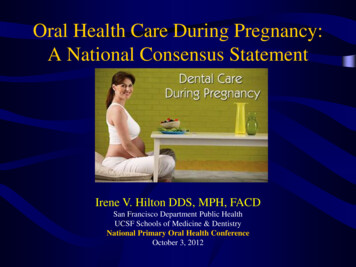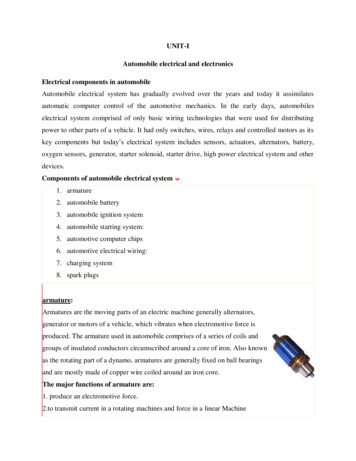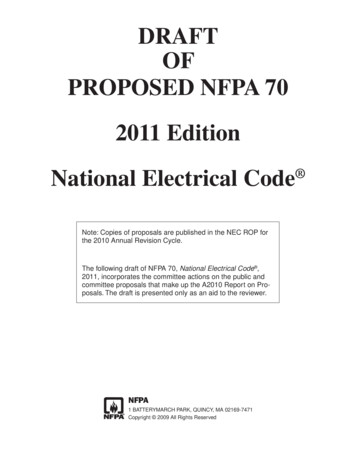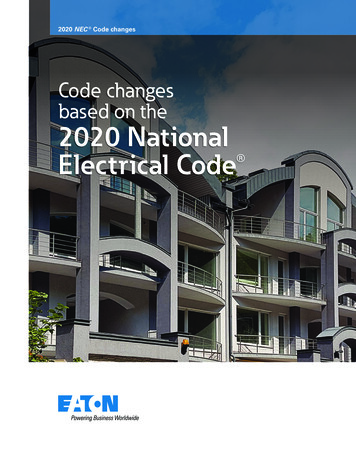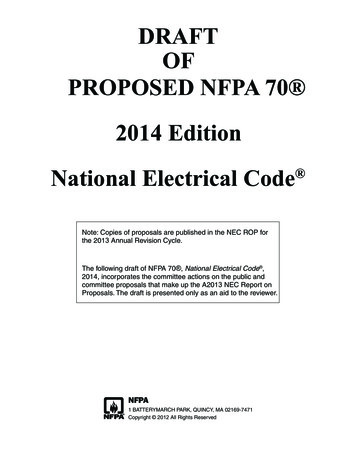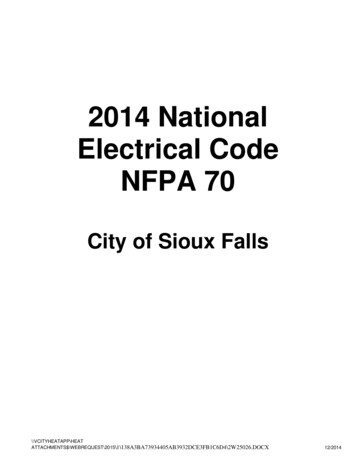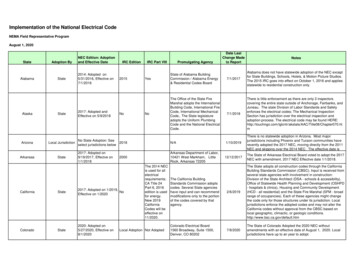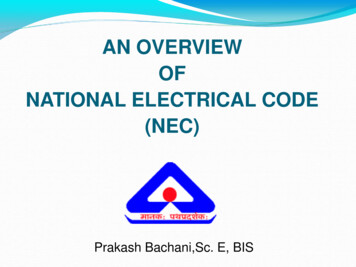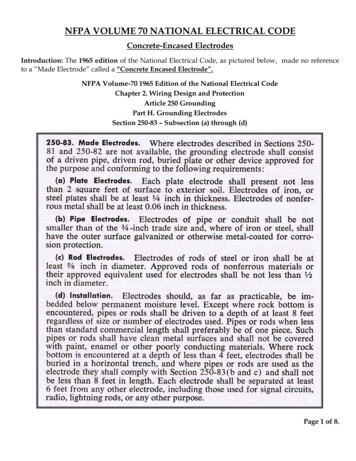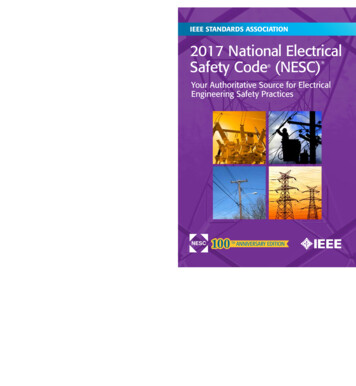
Transcription
ConsensusWE BUILD IT.2017 National ElectricalSafety Code (NESC) Your Authoritative Source for ElectricalEngineering Safety PracticesConnect with us on:Facebook: facebook.com/ieeesaTwitter: @ieeesaLinkedIn: ationBLOGIEEE-SA Standards Insight blog: standardsinsight.comYouTube: youtube.com/IEEESAGoogle : google.com/ IEEESA445 Hoes Lane, Piscataway, NJ 08854 USA standards.ieee.orgTel. 1 732-981-0060 Fax 1 732-562-1571 2016 IEEE004-4-16THANNIVERSARY EDITION Learn more about the National Electrical Safety Code atstandards.ieee.org/about/nesc/
2017 NATIONAL ELECTRICAL SAFETY CODE
General InformationThe National Electrical Safety Code (NESC ) was introduced in 1914 —the product of a congressional mandate for the National Bureau of Standards(NBS) to investigate the hazards of electrical work, contemporary engineeringtheory and generally accepted good industry practice.Over decades, the Code has emerged as a foundational element in theculture of safety that has grown up around the business of installing,operating and maintaining both underground and overhead electricsupply and communication lines, as well as conductors and equipmentin electric supply stations.Utilities, their employees, contractors and manufacturers — as well as telephonecompanies, cable TV providers, railways and other organizations in the exercise offunctioning as a utility — look to the NESC for practical safeguarding guidelines.IEEE’s National Electrical Safety Code (NESC) is also known as American NationalStandard C2. It is a consensus standard that has been prepared by the NationalElectrical Safety Code Committee under procedures approved by the AmericanNational Standards Institute (ANSI). The membership of the NESC Committeeis composed of national organizations and is certified by ANSI as having anappropriate balance of the interests of members of the public, utility workers,regulatory agencies, and the various types of private and public utilities. Utilityregulators in the US and more than 100 nations use the Code at least in part.Published exclusively by IEEE, the NESC is revised every 5 years to keep the Codeup to date and viable.As secretariat for the National Electrical Safety Code, the IEEE also provides acomprehensive offering of resources to assist in obtaining and understandingthe Code.
2017ELECTRICALSAFETYCODE GAINNATIONALINSIGHT ANDINFLUENCEON STANDARDSNESC Revisions from 2012 to 20172017 National Electrical Safety CodeThe NESC has been continually adapted to reflect innovations in technology andnew challenges confronted in the field. The major revisions for the 2017 Editioninclude:This Code covers basic provisions for safeguardingof persons from hazards arising from the installation,operation, or maintenance of (1) conductors andequipment in electric supply stations, and (2)overhead and underground electric supply andcommunication lines. Revising the purpose rule to include only the safeguarding of personsand utility facilities and clarifying the application rules. Deleting unused definitions and adding definitions for communicationand supply space. Revising the substation impenetrable fence requirements. Adding an exception to exempt underground cable grounding requirementsfrom the 4 grounds in each mile rule under certain conditions. Revising and reorganizing the guy insulator placement rules along witheliminating the voltage transfer requirements associated with them. Requiring a 40” vertical clearance from communication cables in thecommunication space if a luminaire is not effectively grounded. Deleting the conductance requirement for underground insulating jacketedgrounded neutral supply cables and revising the grounding and bonding rulesfor supply and communication cables in random separation installations. Revising and reorganizing the Grades of Construction Table 242-1 that willnow include service drops. Revising the strength rules to require that all conductors be considered fordamage due to Aeolian vibration. Revising the rules in Part 4 to align with changes made to 29 CFR by theOccupational Safety and Health Administration (OSHA).It also includes work rules for the construction,maintenance, and operation of electric supply andcommunication lines and equipment. The standard isapplicable to the systems and equipment operated byutilities, or similar systems and equipment, of an industrialestablishment or complex under the control of qualified persons.This standard consists of the introduction, definitions, grounding rules, list ofreferenced and bibliographic documents, and Parts 1, 2, 3, and 4 of the 2017Edition of the National Electrical Safety Code.Learn more about the 2017 NESC and other related products at:www.standards.ieee.org/nesc/For information on institutional and corporate subscription options,please visit: www.ieee.org/nesc-subscriptions
2017ELECTRICALSAFETYCODE GAINNATIONALINSIGHT ANDINFLUENCEON STANDARDSNESC Revisions from 2012 to 20172017 National Electrical Safety CodeThe NESC has been continually adapted to reflect innovations in technology andnew challenges confronted in the field. The major revisions for the 2017 Editioninclude:This Code covers basic provisions for safeguardingof persons from hazards arising from the installation,operation, or maintenance of (1) conductors andequipment in electric supply stations, and (2)overhead and underground electric supply andcommunication lines. Revising the purpose rule to include only the safeguarding of personsand utility facilities and clarifying the application rules. Deleting unused definitions and adding definitions for communicationand supply space. Revising the substation impenetrable fence requirements. Adding an exception to exempt underground cable grounding requirementsfrom the 4 grounds in each mile rule under certain conditions. Revising and reorganizing the guy insulator placement rules along witheliminating the voltage transfer requirements associated with them. Requiring a 40” vertical clearance from communication cables in thecommunication space if a luminaire is not effectively grounded. Deleting the conductance requirement for underground insulating jacketedgrounded neutral supply cables and revising the grounding and bonding rulesfor supply and communication cables in random separation installations. Revising and reorganizing the Grades of Construction Table 242-1 that willnow include service drops. Revising the strength rules to require that all conductors be considered fordamage due to Aeolian vibration. Revising the rules in Part 4 to align with changes made to 29 CFR by theOccupational Safety and Health Administration (OSHA).It also includes work rules for the construction,maintenance, and operation of electric supply andcommunication lines and equipment. The standard isapplicable to the systems and equipment operated byutilities, or similar systems and equipment, of an industrialestablishment or complex under the control of qualified persons.This standard consists of the introduction, definitions, grounding rules, list ofreferenced and bibliographic documents, and Parts 1, 2, 3, and 4 of the 2017Edition of the National Electrical Safety Code.Learn more about the 2017 NESC and other related products at:www.standards.ieee.org/nesc/For information on institutional and corporate subscription options,please visit: www.ieee.org/nesc-subscriptions
2017ELECTRICALSAFETYCODE GAINNATIONALINSIGHT ANDINFLUENCEON STANDARDS2017 NESC HandbookThe 2017 NESC Handbook, Premier Edition,represents a next-generation tool for the professionalwho needs to understand the NESC. It gives usersinsight into what lies behind the NESC’s rules andhow to apply them. Unlike earlier handbooks, thisnew edition includes a representation of the code,with interpretations and background interspersedand coincident with the actual portions of codebeing discussed and highlighted. The handbook wasdeveloped for use at many levels in the electric andcommunication industries, including those involvedin system design, construction, maintenance,inspection, standards development, and workertraining.The handbook also discusses how the NESC Committee has developed therules in the Code and responded to change proposals during the past 90years. This allows users to understand how questions they may encounterwere dealt with in the past.The Premier Edition includes input from members of the NESCSubcommittees and from numerous experts, as well as Allen Clapp.Learn more about the 2017 NESC Handbook at:www.standards.ieee.org/nesc/
2017 NATIONAL ELECTRICAL SAFETY CODE
IEEE’s National Electrical Safety Code (NESC) is also known as American National Standard C2. It is a consensus standard that has been prepared by the National Electrical Safety Code Committee under procedures approved by the American National Standards Institute (ANSI). The membership of the NESC File Size: 551KB
